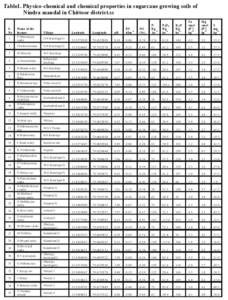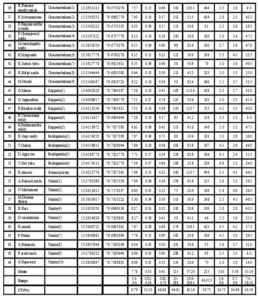SOILFERTILITYSTATUS OFSUGARCANE GROWINGSOILS IN NINDRAMANDALOF CHITTOOR DISTRICT INANDHRAPRADESH.
0 Views
M KAVITHA*, B VAJANTHA, M V S NAIDU, Y REDDI RAMU
Department of Soil Science and Agricultural Chemistry, S.V.Agricultural College,ANGRAU, Tirupati-517 502, Chittoor Dt., Andhra Pradesh
ABSTRACT
A survey was undertaken during the year 2017 to study the available nutrient status of sugarcane growing soils in Nindra mandal of Chittor district, Andhra Pradesh. Sixty four representative soil samples were collected by using GPS from fields of sugarcane growing farmers. The pH (5.3 to 9.4) and EC (0.01 to 0.26 dSm-1) values indicated that the soils were found to be acidic to strongly alkaline in reaction, non-saline in nature. The analysed samples had low to medium organic carbon and available nitrogen, low to high available P2O5 and K2O.
KEYWORDS:
Soil fertility status, sugarcane-growing soils, macronutrients, nutrient status
INTRODUCTION
India ranks second in sugarcane and sugar production after Brazil and the crop is grown in the country both in tropical and sub-tropical regions. Andhra Pradesh ranks fifth in sugarcane crop area of the country with a share of 4.83 per cent. In Andhra Pradesh, the major sugarcane growing districts are Vishakapatnam, Krishna, Nellore and Chittoor. Area coverage, production and productivity of sugarcane in Andhra Pradesh are 1.22 m ha, 93.53 lakh tons and 76.7 tonnes ha-
1 (sugarcane.dac.gov.in/StatisticsAPY.pdf, 2015), respectively while sugarcane production in Chittoor district is to an extent of 26,000 ha with a productivity of 79.05 t ha-1. Farmers in Chittoor district are raising sugarcane with higher dose of complex fertilizers but not applying required quantity of nutrients or recommended dose of nutrients at the correct time, consequently, getting low yields and less sugar recovery per unit of sugarcane. Keeping the above facts in view, the present investigation was taken up.
MATERIALAND METHODS
The study area Nindra mandal lies in between 130 18′ 5.23 Northern latitude and 790 44′ 73 of Eastern longitude in Chittoor district and the investigation was carried in the year 2017. Sixty four soil samples were collected from sugarcane growing fields of Nindra mandal
in Chittoor district. From each field soil samples were collected randomly from depth of 0-20 cm and the samples in each field were composited, so as to obtain one composite sample from each field totaling to 64 soil samples.
All the samples were analysed for pH, EC, organic carbon as per the standard procedures (Jockson, 1973). Available N was determined by alkaline permanganate method. The available P was extracted with the 0.5 M NaHCO3 extractant and determined by using ascorbic acid as reducing agent and the available K in the soils was extracted by employing Neutral normal ammonium acetate and determined by aspirating the extract into the flame photometer, calcium and magnesium were extracted with neutral normal ammonium acetate and the content was determined by versenate titration method (Jackson, 1973). Available sulphur was determined by extracting with 0.15 per cent calcium chloride followed by development of turbidity with barium chloride (Hesse, 1971).
Soil samples were rated as low, medium and high categories as per the limits suggested by Ahmed et al. (2007) for pH, EC, OC, available N, P2O5 and K2O. The available calcium and magnesium were classified based on the critical limits given by Tandon (1989) and available sulphur was classified based on the critical limits given by Tandon (1991).
RESULTSAND DISCUSSION
Soil pH, EC and Organic carbon:
Soil reaction in the sugarcane growing soils varied from acidic to strongly alkaline (5.3 to 9.40). The variation in soil pH might be attributed to the variation in nature of parent materials and degree of weathering. Similar findings were reported by Devi et al. (2015). The soils were non-saline with EC values ranging between 0.01 to 0.26 dSm-1 with the mean value of 0.11 dSm-1. The CV (51.01 %) of EC values indicated that salt content in Nindra varied spatially.
The organic carbon content in the soils ranged from 0.01 to 0.75 per cent with a mean value of 0.41 per cent. The CV value of 48.84 per cent indicates that, organic carbon in the soils varied spatially The lower organic carbon content in these soils might be due to the prevalence of tropical conditions where the decompition of organic matter occurs at a faster rate coupled with low vegetative cover in previous years, thereby leaving less organic carbon in the soils. These findings were in
good agreement with the findings of Verma et al., (2016).
Available N, P2O5 and K2O:
The available nitrogen in sugarcane growing soils were low to medium (25 to 228 kg ha-1) with the mean value of 115 kg ha-1. The CV value of 44.91 per cent indicates that, available nitrogen in soils varied spatially in the study area. The low available nitrogen status of these soils might be attributed to the low organic matter content. Further, the semi-arid conditions of the area might have favoured rapid oxidation and lesser accumulation of organic matter releasing more NO3-N which could have been lost by leaching (Finck and Venkateswarlu, 1982). The sugarcane growing soils were low to high available P2O5 (19.5 to 206.1 kg ha-1) with the mean values of 57.20 kg ha-1. The CV of 63.16 per cent for available P2O5 in the Nindra mandal indicates that, it varied spatially. Presence of the considerable amount of phosphorus in sugarcane growing soils might be due to the continuous use of phophatic fertilizers and adopting good management practices. Available potassium (K2O) of the soils under investigation
was ranged from low to high (42 to 515 kg ha-1) with a mean value of 215 kg ha-1. The CV of 56.75 per cent for available K2O indicates that, it varied spatially in Nindra mandal. The higher values of K2O could be attributed to more intense weathering, release of K from organic residues, application of K fertilizers and upward translocation of potassium from lower depth along the capillary raise of ground water. These findings were in agreement with the findings of Rao et al. (2008).
Available Ca, Mg and S:
The available calcium in sugarcane growing soils of Nindra mandal was ranged from 1.8 to 6.8 cmol (p+) kg-1 soil with a mean value of 3.61 cmol (p+) kg-1 soil. The CV of 34.75 per cent for available calcium indicates that, it varied spatially. All the samples were sufficient in Ca and this might be due to fact that soils might be formed from the basic parent materials rich in calcium. Similar findings were also reported by Prasanna et al. (2017). The avail-able magnesium in the soils varied from 0.7 to 6.8 cmol (p+) kg-1 soil with a mean value of 3.58 cmol (p+) kg-1 soil. The CV of 34.68 per cent for available magnesium indicates that, it varied spatially in the study area. The available sulphur in sugarcane growing soils of study area ranged from 0.5 to 58.50 mg kg-1 soil with a mean value of 33.16 mg kg-1 soil. The CV of 43.58 per cent for available sul-phur indicates that, it varied spatially in Nindra mandal of Chittoor district.The higher sulphur in these soils might beto the continuous application of fertilisers like single super phosphate. These results were in confirmation with those reported by Bankar et al. (2014).
The results lead to a conclusion that the sugarcane growing soils in Nindra mandal of Chittoor district are acidic to strongly alkaline in reaction and non-saline in nature. The organic carbon content and available nitrogen is low to medium, where as available P2O5 and K2O were low to high. The available Ca, Mg and S were defficient to sufficient. Therefore effective measures viz., adoption of soil test based recommendations, integrated use of organic and inorganic fertilizers will helps the farmers in achieving sustainable yields.


LITERATURE CITED
- Ahmed, S.R., Reddy, D.V.R., Muralidharudu, Y and Rao, A.S. 2007. Soil test based fertilizer application. ICAR, ANGRAU and dept. of Agriculture, Andhra Pradesh. ANGRAU press, Hyderabad, pp 34-35.
- Bankar, R.T., Ganesh, K. Gaikwad, Puri, A.N and Adsul, P.B. 2014. Status of available nutrients in sugarcane growing soils from Ambajogai in Maharashtra State. BIOINFOLET. 11 (4A): 1085- 1086.
- Devi, P.A.V and Naidu M.V.S. 2015. Nutrient status of sugarcane growing soils of chittoor district in Andhrapradesh. BIOINFOLET 12 (4A): 864-872.
- Finck A and Venkateswarulu J 1982. Chemical properties and fertility management of Vertisols. In vertisols and rice soils in the tropics. Symposia of 12 th International Congress of Soil Science, New Delhi held on 8-16. Feb.1982.
- Hesse, P. R 1971. A text book of soil chemical analysis John Murray Ltd. London, UK.
- Jackson, M.L. 1973. Soil Chemical Analysis. Oxford IBH Publishing House, Bombay.38.
-
Prasanna, K.L., Vani, P.M., Rani, P.R and Venkateswarlu, B. 2017. Fertility status of soils of Narasaraopet revenue division in Guntur district of Andhra Pradesh. The Andhra Agricultural Journal. 64
(1): 107-115. - Rao, A.P.V., Naidu, M.V.S., Ramavatharam, N and Rao, G.R. 2008. Characterization, classification and evaluation of soils on different land forms in Ramachandrapuram mandal of Chittoor district in Andhra Pradesh for sustainable land use planning. Journal of Indian Society of Soil
- Science. 56(1): 23-33.
- Tandon, H.L.S. 1989. Secondary and Micronutrient Recommendation for Soils and Crops. A guide book. 22.
- Tandon H L S 1991. Sulphur research and agricultural production in India. 3rd edition, The Sulphur Institute, Washington, D C. 140-148.
- Verma, R.R., Srivastava, T.K and Singh, K.P. 2016. Fertility status of major sugarcane growing soils of Punjab. Journal of the Indian Society of Soil Science. 64 (4): 427-431
- Bio-Formulations for Plant Growth-Promoting Streptomyces SP.
- Brand Preference of Farmers for Maize Seed
- Issues That Consumer Experience Towards Online Food Delivery (Ofd) Services in Tirupati City
- Influence of High Density Planting on Yield Parameters of Super Early and Mid Early Varieties of Redgram (Cajanus Cajan (L.) Millsp.)
- Influence of Iron, Zinc and Supplemental N P K on Yield and Yield Attributes of Dry Direct Sown Rice
- Effect of Soil and Foliar Application of Nutrients on the Performance of Bold Seeded Groundnut (Arachis Hypogaea L.)

